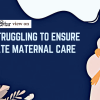Kapasia model: Drastically reduced maternal deaths

Back in 2017, a baseline survey conducted by Kapasia Upazila Family Planning Office (UFPO), Gazipur found that more than 90 percent of the mothers-to-be of the subdistrict were unaware of the maternal and neonatal danger signs, the idea and importance of antenatal and postnatal care or keeping their medical records during pregnancies, the importance of knowing their own blood groups, and keeping contact of potential blood donors or an ambulance.
At the same time, there was a gap between these women and the health facilities, which hinders them to take better medical services during pregnancies.
Inevitably, a total of eight mothers of the upazila died during childbirth in 2017.
Kapasia Upazila Family Planning Office (UFPO), however, was able to decrease the maternal deaths to four in 2018, one in 2019, zero in 2020, and one in 2021, thanks to a model that brought all pregnant mothers under a digital service system called "Gorbhobotir Aaina" (Smart MCH Service Management Software), and raised awareness at the community level through a 44-page mother and child healthcare handbook titled "Gorbhobotir Goina".
Initiated in December 2017, the model, known as the "Maternal Death Free Kapasia Model', has been recognised as one of the best practices in reducing maternal, newborn and child mortality by UNFPA and Partners in Population and Development (PPD) and received Public Administration award in 2020 in recognition to drop the maternal mortality rate to almost zero.
In 2020, the government also took the initiative to replicate the model in 100 upazilas of the country.
Md Abdur Rahim, Kapasia Upazila Family Planning Officer, who conducted the survey and initiated the model under the patronage and leadership of Simeen Hussain Rimi, Member of Parliament from Kapasia (Gazipur-4 constituency), said that after interviewing 110 mothers, what he realised was that if proper information and services could be delivered at right time and at the right place, maternal mortality could be reduced significantly.
"At first, we developed a database that includes 37 types of data on pregnant women, such as the total number of registered pregnant women, high-risk mothers (identified based on age, height, blood group, number of pregnancies, age of the previous child, number of c-sections etc.), number of blood donors, poverty, newborn babies, enlisted office staff etc.," he said.
"And through the dashboard, we were able to ensure the four ANCs and PNCs very efficiently," he said.
"For example, when a newly pregnant woman's information is added to the software, the ANC dates appear automatically in blue colour. If the date is overdue, the date colour becomes red. The data entry operator from UFPO calls her and includes the information in the database just to see whether she attended her ANC service at the nearest Union Health and Family Welfare Center (UHFWC) or other service centres," he said. "This is applicable for PNCs too."
"Besides, before every ANCs and PNCs, mothers are being informed about the time, place and name of service providers, through Bangla SMS and voice calls, which resulted in a significant increase in the number of prenatal and postnatal appointments and institution deliveries," said Rahim.
"As soon as the pregnant woman gets her delivery done successfully, the data is then transferred to the newborn babies list," he added.
"And, from 2018 till February 2022, a total of 14,218 safe deliveries were possible under this model, while the maximum number of ANCs has been ensured through more than 84,000 SMS and 25,000 voice calls," Rahim informed this correspondent.
On the other hand, the "Gorbhobotir Goina"handbook, which contains all the necessary information for a pregnant mother, is being issued to each pregnant mother with a separate ID by collecting the pregnancy information in the prescribed form at the field.
The illustrated description of nutrition information, maternal and neonatal danger signs, importance of mental healthcare for the mother and the baby, prenatal and postnatal checkups, institutional delivery, postpartum family planning, information regarding the development of the babies etc. has been helping pregnant mothers to be better aware of their health.
Mother-to-be Najmunnahar Akter (27), who had a stillbirth four years ago, said now she has become more aware than before.
"If I had this handbook before, I could learn a lot about the baby movement and notice it more frequently," she said.
"Besides, earlier I was totally unaware of where to go or who to call in emergencies. Now this book has the emergency ambulance numbers, all phone numbers related to health and family planning services of Kapasia and blood donors, which is why, this time I am much more confident," she added.
Apart from the digital database and handbook, the Kapasia model also enabled a mother and Child Health Corner at the upazila complex hospital, so that pregnant mothers and newborns get a one-stop service there.
A database of union, ward and village-based voluntary blood donors has been compiled by organising free blood group testing campaigns based on the unions, while a total of 33 voluntary motorbike riders in 11 unions have been working on bringing the donors to the hospital when necessary.
In addition, 198 traditional midwives were trained for six days to ensure safe delivery and provided with necessary kits, while a number of awareness activities – setting up display boards in every union and nameplates in front of the service providers' house, arranging pregnant mothers conference, creating a humanitarian fund are also notable under the model.
LIMITATIONS APLENTY
Although the model has ensured almost zero maternal death in the upazila, the activities are being thwarted in three unions due to a lack of manpower.
"In addition to that, although there are supposed to be 10 family welfare visitors and 77 family welfare assistants to provide door-to-door services and services at the UHFWCs, there is no manpower in half of the posts," said Rahim.
Another important fact is that the union centres receive only 2,000 pieces of iron and folic acid supplements, 500 pieces of calcium carbonate and 1,000 pieces of vitamin B complexes, which are far less than the actual demand for an average of 250 pregnant women in each union.
"Most of the time, we run out of our stock after providing medicines to 16-20 women," said Md Humayun Kabir, pharmacist of Chandpur UHFWC of the upazila.
However, Rahim said although very recently, the supply has doubled, that too is disproportionate to the actual number of women.
According to Rahim, if this model could be brought into the regular work of the ministry, it would be possible to achieve SDG 3.1 (reducing maternal mortality ratio to less than 70 per 100000 live births) and SDG 3.2 (reducing neonatal mortality to at least as low as 12 per 1000 live births and under-5 mortality to 25 per 1000 live births).
"But what is sadder, although one and a half years have passed, no significant actions have been taken to replicate the model in 100 upazilas," concluded a frustrated Rahim.

 For all latest news, follow The Daily Star's Google News channel.
For all latest news, follow The Daily Star's Google News channel. 








Comments